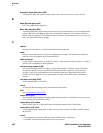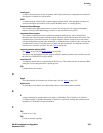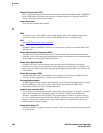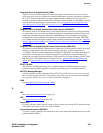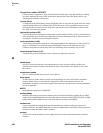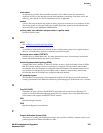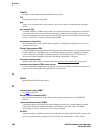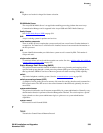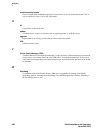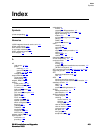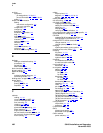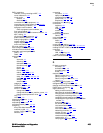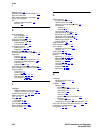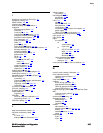
Glossary
Q
398 S8100 Installation and Upgrades
November 2003
PCMCIA
Personal Computer Memory Card International Association.
PID
Product ID (also know as Alarm ID)
port
A data- or voice-transmission access point on a device that is used for communicating with other
devices.
port network (PN)
A cabinet containing a TDM bus and packet bus to which the following components are connected:
port circuit packs, one or two tone-clock circuit packs, a maintenance circuit pack, service circuit
packs, and (optionally) up to four expansion interface (EI) circuit packs. Each PN is controlled either
locally or remotely by a switch processing element (SPE).
port-network connectivity
The interconnection of port networks (PNs), regardless of whether the configuration uses direct or
switched connectivity.
Primary Rate Interface (PRI)
A standard ISDN frame format that specifies the protocol used between two or more communications
systems. PRI runs at 1.544 Mbps and, as used in North America, provides 23 64-kbps B channels
(voice or data) and one 64-kbps D channel (signaling). The D channel is the 24
th
channel of the
interface and contains multiplexed signaling information for the other 23 channels.
Processor Interface cable
Octopus cable, splitter cable, or multileg cable. See Install and cable a G600 cabinet
on page 57.
processor port network (PPN) control carrier
A carrier containing the maintenance circuit pack, tone/clock circuit pack, and SPE circuit packs for a
processor port network (PPN) and, optionally, port circuit packs.
Q
QPPCN
Quality Protection Plan Change Notice.
R
rack-mounted cabinet (RMC)
See G600
on page 394.
Remote Feature Activation (RFA)
The web-based system that is used to deploy license and password files for every DEFINITY
platform.
remote maintenance board (RMB)
A board provided in adjunct processors that intelligently monitors the system hardware for health
status. These include environmental conditions, PC heartbeat, and sanity checks. The RMB
functionality also allows modem access to the TN parent board.
RS-232C
A physical interface specified by the Electronic Industries Association (EIA). RS-232C transmits and
receives asynchronous data at speeds of up to 19.2 kbps over cable distances of up to 50 feet.





